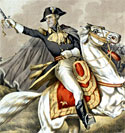 |
 |
|
|
Andrew Jackson was the most powerful man of his era --
and the personal nemesis of the Black Seminoles. He first
crossed their path in 1815: See
related trail segment. |
What is the purpose of this site?
The purpose of this site is two-fold:
- To present a great American story, engaging visitors with the little known
history of the Black Seminoles; and,
- To present this story using the strengths (and avoiding
the weaknesses) of the
Internet as a communications medium.
Who is the intended audience?
This site is intended for all people with an interest in American history. Students of all ages may find the material engaging, but the site is written for general, adult audiences.
With a wealth of primary materials, images, and quotations
presented in a carefully structured narrative, the site is designed to appeal to both
general readers and specialists alike.
Back to Top
What kind of site is this?
Rebellion is a stand-alone Web documentary
created specifically for the Internet.
There are many documentary-oriented sites that serve as
companion-pieces to television shows -- Rebellion is
not one of these. The companion sites usually give a taste of the
television material while avoiding a full presentation of its
content over the Web. (Africans in
America, the companion site to the PBS documentary series of
the same name, is
a notable exception.) Almost none of these sites attempt to tell a
feature- or book-length story online.
Rebellion, in contrast, is designed to
tell a story online in all its breadth and depth while
offering visitors the chance to explore a wealth of images, primary
documents, and historical topics.
The story unfolds in more than 370 story panels -- individual pages that combine text and imagery, much like the panels in a museum
exhibit. You can move through the slides from start to finish, in a linear fashion,
or you can explore the story in several other ways, for
instance, through an image
outline, a series of interactive maps and
timelines,
extracts on individual characters,
analyses of key
images, or even a directory of related Web
sites.
These non-linear options (except for the other Web sites) all lead back to
the trail narrative. The narrative is linear, moving from
start to finish like the pages in a book. Even here, however,
there are tons of images and numerous
digressions (called "sidetracks") that allow you to delve into various topics in greater detail. The text,
meanwhile, is presented in short bites structured into brief
story segments. This is so the average Web reader, who
usually does not have much time, can get part of the story and
then decide whether or not to come back later and pick up the thread.
Overall, the idea is to take advantage of the ways that people
seem to like accessing information online, such as:
- Scanning
- Browsing
- Searching
- Clicking on links
- Exploring
- Viewing images
None of these ideas are mine, by the way, they are all stolen from
Jakob Nielson of useit.com.
Finally, some of the ideas behind this site are particular
to the presentation of history and topics in the
humanities.
While preparing this documentary I surveyed a number of
historical Web sites. There are some great ones out there. In general, however, the Web is seriously lacking as far as the presentation of
history is concerned.
The biggest single problem is simple: the failure to cite sources.
If the Web were a 10th-grade research paper, its author would
be expelled from school, either for serial plagiarism or flagrant
disinformation. If you are creating an historical Web site,
please cite your sources!
While wrestling with this and other concerns, I wrote down
some of the principles that went into this site. At the risk of great
pretense, I will share some of them, which I think are decent principles for any
humanities-oriented site.
- Show your sources, for text and images.
Otherwise no
one can cross-check your material or find it on their own.
- Offer primary materials or links to them.
This is one
of the great things about the Web.
- Respect copyrights & permissions.
Artists deserve
the protection, and archives deserve licensing fees, so they can
continue to offer materials to the public.
- Respect your audience.
Write for interested readers,
not a mythical audience of 10-year-olds.
- Be linear and non-linear.
Offer multiple ways to your information.
- Leave information to be found.
Browsing for information is what people like to do
most on the Web.
- Write in short segments and sequences.
The printed page is a better
way to read long blocks of text. Don't fight this, work with it.
- Design with purpose.
Beautiful design is fine -- especially when
it leads to interesting content.
Back to Top
|